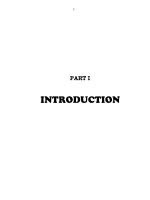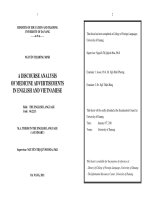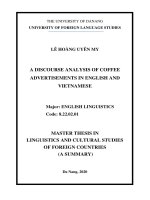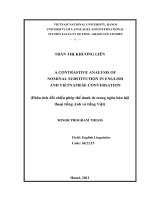An analysis of metaphors relating to upper parts of human body in English and Vietnamese.
Bạn đang xem bản rút gọn của tài liệu. Xem và tải ngay bản đầy đủ của tài liệu tại đây (64.59 KB, 12 trang )
Topic: An analysis of metaphors relating to upper parts of human body in English
and Vietnamese.
By: Trần Thị Thu Hiền _ K17B ->K18C
1. Introduction
It is common knowledge that one of the most important functions of language is to name
the world or express human thoughts through a system of concepts. However, the
concepts expressed through language do not exist in isolation from each other. Rather,
they exist associatively in the language and make up a giant network with many
interconnections and associations among the various subparts. A good example of these
interconnections involves metaphor, the understanding of one concept in terms of
another.
One interesting idea in the language use is that the human beings,first of all, got to know
their own body and gave names to its parts. Later in the process of cognition of the world
they began comparing the surrounding objects with their own body and finding common
features. Hence the names of parts of human body are transferred to denote many other
things or parts of things in the real world. In such a way, things or parts of things in the
real world are personified to possess the same names with the parts of human body. For
example in English, the word “foot” refers to the lowest part of the human being and later
on it is metaphorically used to refer to the lowest part of many things, for instance, “the
foot of the mountain”.
Not only English but many other languages also make use of metaphors in such a way. In
Vietnamese, many words denoting parts of human body are also used metaphorically. For
example, the word “chân”, equipvalent to the word “foot” in English is also used as a
metaphor to refer to the lowest part of the mountain or hill: “chân núi/ chân đồi”.
However, the way individual words are used is not always the same in the two languages.
For example, the word “eye” in English is metaphorically used to refer to the hole of the
needle, “eye of the needle”.
Whereas, in Vietnamese the word “mắt” is not used in such a way. But instead in another
case, it is metaphorically used to refer to holes of a woven basket, “mắt rổ”.
Examining the examples above it is obvious that in both English and Vietnamese, the
words denoting parts of human body are used metaphorically but the way each word is
used is varied in two languages. This can be explained that the way metaphors are
utilized is due to people’s life experience, worldview or people’s cognition of the outside
world. In the boarder terms, it is also due to the language users’s culture. For this reason,
metaphors are varied from one language to another.
2. Development
2.1. Metaphors in English
2.1.1. What is metaphor?
The term metaphor that comes from Greek means “transference”. As it is stated by Vo
Dai Quang (2003: 33), metaphor is “word meaning transference based on similarity
between two things as regards function, character, size, shape, age, colour, etc.”
This is clearer in the definition given by Oxford Advanced Learner’s Dictionary (1995:
734) in which metaphor is defined as “the imaginative use of a word or a phrase to
describe somebody/ something as another object in order to show that they have the same
qualities and as to make the description more forceful”. This definition is not as detailed
as the above-mentioned definition about the association of similarity but it takes the use
and the effect of metaphor into consideration.
From the linguistic point of view, metaphor is defined as “an extension in the use of the
word beyond its primary meaning to describe referents that bear similarities to the word’s
primary referent” (Language- its structure and use, 1994).
In general, metaphor discussed above is viewed from different angles. To put it simply, it
is the way we call one object by the name of another because we compare these objects
and find some common features between them.
There is a necessity here to distinguish metaphor from simile and metonymy because
they are closely related. Firstly, metaphor and simile are forms of comparison. In both
ways, we compare two unlike things together. However, metaphor is the hidden
comparison and simile is the open comparison. Secondly, metaphor and metonymy are
two kinds of transference of meaning. That is, one object is named and understood in
terms of another. But metaphor is based on the association of similarity and metonymy is
based on the association of contiguity.
So it is obvious that metaphor are related to simile and metonymy but it is quite
distinguished from them. And how metaphors function in language and how they are
subclassified will be presented below.
2.1.2. Functions of metaphors
The first function of metaphors discussed is to name things. This is only the technical
means to use the ready-made vocabulary to give names to other things basing on the
resemblance between them. These metaphors are of almost no or very little rhetoric value
but they can reflect the way in which things in the world are viewed together. These
metaphors are only intended to give names to things basing on the experience with the
existing vocabulary.
The second function of metaphors is to cognize or conceptualize things. Here the
metaphors do not give new names to things but conceptualize them in terms of another.
Here, metaphors operates between two domains, one domain is conceptualized in terms
of another.
The last function of metaphors mentioned here is to symbolize things. This function is
commonly thought to be the conventional function of metaphors. Metaphors of this group
reflect the imaginative and creative way individuals judge and comment things, which
can make their language more expensive and more persuasive. They are very popular in
poetic language.
On the whole, metaphors carry three major functions in language which are naming,
cognitive and symbolic functions. Basing on that, metaphors relating to parts of human
body are the first group which are utilized to give names to things in the world.
2.1.3. Kinds of metaphors
Metaphors, like any other stylistic devices, can be classified according to their degree
unexpectedness. As it is stated by Nguyen Hoa (2004: 109), basing on the degree of
unexpectedness, there are three main types of metaphors namely living metaphors, faded
metaphors and dead metaphors.
Metaphors which are unexpected and quite unpredictable are called living metaphors. In
these metaphors the word has an unusual metaphorical sense that are easily recognized by
the hearer. They are created and used by individuals. The metaphors of this type are also
called creative or poetic metaphors as discussed above and are especially used in
literature and poetry. They are not common in everyday language usage. Sometimes, they
are called genuine metaphors because it is the common sense when people talk about
metaphors and they have great rhetoric effect on the hearer.
Faded metaphors are those which have lost their freshness because of long and traditional
use and become habitual in daily language usage. Metaphors are so common in everyday
language that they are sometimes not felt as metaphors. These metaphors can cause
polysemy of so many words in language. Among the functions discussed, they are
attached to the naming and cognitive functions.
Dead metaphors are those whose metaphorical sense is not felt at all because they have
lost their indirect meaning and are only used figuratively. These metaphors are not many
in language. In fact, they are difficult or almost impossible to be recognized as
metaphors.
Generally, there are three main types of metaphors which are living, faded and dead
metaphors. Basing on these, metaphors relating to parts of human body are called faded
metaphors because they are the means of everydat language to give names to things in the
world. This will be clarified with illustrations in the following parts.
2.2. Metaphors relating to parts of human body in English and Vietnamese
First of all, it is necessary to recall the metaphors are an integral part of language and
thought and metaphors relating to partsof human body are a good example for this. These
metaphors can reflect how people think and reason about things in the world and how
they are related to parts of human body. These metaphors, as mentioned above, are faded
metaphors which are used to give names to things in the surrounding and become part of
ordinary language. In fact, both English and Vietnamese make use of these metaphors.
What is in common in both languages is that both English and Vietnamese people
understand parts of human body well but the way they relate hem to name other things is
not always the same. When the words denoting parts of human body are used in
metaphors, one or several certain semes or semantic features are transferred will be
carefully discussed in both English and Vietnamese in this part. The words denoting parts
of human body in the two languages which are discussed in this study are grouped in
terms of their position on the human body under the heading, upper parts.
2.2.1. Metaphors relating to “head” in English and “đầu” in Vietnamese
It can be seen that the word “head” in English and “đầu” in Vietnamese are popularly
used in metaphor. The metaphors relating to them are mostly based on the similarity of
function and position. These are some basic metaphors. Firstly, the word “head” in
English refers to the leader of a group or an organization. For the head containing the
brain of the human beings has the function of controlling other parts of the human body.
Similarly, as the leader of a group or company also controls the whole group or
organization so that kind of person is labeled the head of the group or organization.
Ex: English: “He had also worked for a time in business in Paris and as head of modern
languages at London grammar school.” (Alice Deignan: 7).
The word “head” in the example above refers to the leader of the modern language
department. In this way, the word “head” refers to many other referents for example,
“head of the class, head of the school, head of the college/ university, head of the
company/ factory, head of the delegation, head of othe government, head of the state/
country, …etc.
However, in Vietnamese, the word “đầu” is not used in such a way. It should be noted
here that in both English and Vietnamese, the words denoting to the head are also used as
a verb and adjective in metaphors but this is not supposed to be mentioned or discussed
this in this study.
Secondly, the word “head” in English and “đầu” in Vietnamese are both used to refer to
other referents on the basis of similar position. When people take parts of human body
into consideration, they always consider the head as the first, highest and foremost part of
all in comparison with the other parts especially the foot. So, the first referents that they
metaphorically refer to are the first and more important part of a place or a thing. Take
the following examples.
Ex: English: Place the pillow at the head of the bed,
Vietnamese: Đặt những chiếc gối ở đầu giường.
(English-Vietnamese Dictionary, 1993: 779)
Obviouly, the head of the bed is taken as the first and more important part rather than the
opposite end as we often lie and place our head on this part. This is one of the productive
use of the words “head” and “đầu” in both languages.
Additionally, the word “head” and “đầu” are also used to refer to the abstract thing that is
at the highest position in a system or a class. Take the English example first:
Ex: English: He is at the head of his profession. (English-Vietnamese Dict, 1993: 779)
In this example, he is the best and ranks the first in the profession. Similarly, in
Vietnamese, it is also used in such a way.
Ex: Vietnamese: Anh ấy đỗ đầu bảng. (Từ điển Tiếng Việt, 2003: 299)
In the above sentence, the person passes the exam with the highest marks and holds the
highest position in the list of the students who took the exam. This use of both words
“head” and “đầu” is so various in communication that cannot be taken into account here.
Furthermore, in Vietnamese, the word “đầu” is used to denote an abstract thing such as
time concepts. It refers to the first period in a duration of a time or process of an event
while in English, the word “head” is not used in this way.
Ex: đầu mùa, đầu tuần, đầu tháng, đầu năm, đầu thập kỷ, đầu thiên niên kỷ, đầu kỳ học
đầu tiết học, …etc.
In general, metaphors relating to the head are many in both English and Vietnamese and
these metaphors mentioned and discussed above are basic and common in both
languages.
2.2.2. Metaphors relating to “face” in English and “mặt” in Vietnamese.
Firstly, the face is seen as one side on the head so in both English and Vietnamese it is
used to refer to the sides of things. Take the following examples.
Ex: English: A cut diamond has many faces,
Vietnamese: Một viên kim cương đã cắt có nhiều mặt.
(English-Vietnamese Dictionary, 1993: 584).
So each face of the diamond mentioned in the examples is one side of the diamond as the
face is one side of the head. However, in some cases, English and Vietnamese words
denoting the face do not share the same referent.
Ex: English: The ream climbed the North face of the mountain
(English-Vietnamese Dictionary, 1993: 584).
In this case, the face of the mountain here is one side of the mountain. To convey this
meaning, in Vietnamese, we can use the words “sườn núi” or “lưng núi” (this will be
discussed in the part discussing use of the world “back” and “lưng”). The basis for this
will be discussed just below. Addition to that association, in position, the face is situated
on the from side which is considered the main side of the head so it also has similar
position to many things in the world. For example, it is possible to say as in the following
examples.
Ex: English: There is a crack on the face of the clock,
Vietnamese: Có một vết nứt trên mặt đồng hồ.
(English-Vietnamese Dictionary, 1993: 584).
The face of the clock here refers to the front part of the clock that shows the time. So both
English and Vietnamese share this feature. Moreover, the face is on the head, that is, it is
on the top of the human body, so it is also used to refer to part at the top of many things.
Ex: English: They disapperared from the face of the earth,
Vietnamese: Chúng đã biến khỏi mặt đất.
(English-Vietnamese Dictionary, 1993: 584).
The face of the earth here is the top level of the earth on which we are living.
Another important aspect in the metaphorical use of the words denoting the face in two
languages is that both languages make use the words to denote abstract meanings. As the
face is the expression of our mood or feeling and through the face, we can possibly know
what people think or how they feel. So it is metaphorically used to refer to the general
appearance of something.
Ex: English: Developments that have changed the face of the society
(Oxford Advanced Learner’s Dictionary, 1995: 431).
The face of the society here refers to the aspect or appearance of the society through
which we can possibly see its internal characteristics. In Vietnamese, it is possible to say
“bộ mặt của xã hội” to imply the similar meaning. This meaning is also common in both
languages.
Furthermore, as mentioned, the face is one side of the head so it is used in abstract
meaning to denote aspects of something.
Ex: English: The many faces of criminal activity.
(Oxford Advanced Learner’s Dictionary, 1995: 413)
In the above example, the word “faces” here refers to different aspects of the activity. In
Vietnamese, it is possible to say: “Nhiều mặt của hành động phạm tội”. Moreover, the
face, as one side of the head, is often constrasted with the back side of the head. Thus, the
word “face” is also metaphorically used to refer to one of the two sides or aspects of the
thing.
Ex: English: … the acceptable face of Soviet foreign policy. (Alice Deignan: 7)
The acceptable face of the policy here is one aspect in contrast with the other aspect that
is the unacceptable face. In Vietnamese, the word “mặt” is also used in a similar way.
Ex: Vietnamese: Mặt trái lối viết cả Thuần liệu có dẫn đến nguy cơ “cưa sừng làm nghé
khơng? Nhà văn Hồ Anh Thái đã gọi bạn là “Hoàng Tử Bé” của văn chương tuổi học
trị.” (Thể thao văn hóa, 16/7/2004).
In this sentence, the word “mặt trái” that means the negative side is contrasted with the
positive side of the writing style of the writer. Basing on what has been mentioned, there
are many similarities in the metaphorical use of the words denoting the face in English
and Vietnamese.
2.2.3. Metaphors relating to “eye” in English and “mắt” in Vietnamese
It is also possible to find some common features in the metaphorical use of the words
denoting eyes in the two languages. First of all, as our eyes are round and small in shape,
in both in English and Vietnamese, the words “eye” and “mắt” refer to the rounded and
small spot on a potato from which a new plant can grow.
Ex: English: Eye of the potato,
Vietnamese: Mắt khoai tây
(English-Vietnamese Dictionary, 1993: 581).
In addition to this, in Vietnamese, the word “mắt” is used to refer to many small and
rounded-shaped things on the peel of many kinds of fruit and things. But in English, the
word “eye” is not used in these cases, for example, “mắt nai, mắt dứa, mắt võng, mắt
lưới, mắt rổ, mắt xích, …etc”.
However, the word “eye” in English is figuratively used to refer to the eye-shaped spots
on the tail of the peacock.
Ex: English: Eye of the peacock’s tail. (Vocabulary, 26).
Moreover, the word “eye” is also used to denote the eye-shaped pieace of mental used
together with a hook for fastening clothes.
Ex: English: Hook and eye of the dress. (Oxford Advanced Learner’s Dict, 1995: 410).
Secondly, on the basis of the quality of quietness and peacefulness when we see into a
person’s eyes and the central position when we see around, in both English and
Vietnamese, the words “eye” and “mắt” both figuratively refer to the calm centre of the
storm or cyclone.
Ex: English: Eye of the storm,
Vietnamese: Mắt bão
(English-Vietnamese Dictionary, 1993: 581).
Similarly, on the basis of the central position of the eyes when we see around, the word
“eye” in English also refers to the centre or point from which the wind blows.
Ex: English: Eye of the wind (English-Vietnamese Dictionary, 1993: 581).
There is a very interesting thing when English people use the word “eye” metaphorically
basing on its function. When we open our eyes and see, the world around us is bright and
clear. Similaryly, when the sun rises and opens on the day, the world is also bright. So
English people calls the sun “the eye of the day” in a figurative meaning. In addition, as
our eyes function as organs of sight used to see or to observe, English people also call the
private spy, who has function of observing others secretly to get information, the private
eye. However, Vietnamese does not share these interesting features with English.
Hence, unlike the metaphorical use of the words denoting the face, there are many
distinguished features of English in the use of the word “eye” in comparison with the
word “mắt” in Vietnamese.
Basing on what has been discussed in this part, it is possible now to have a full or at least
very clear view on the basic metaphors relating to upper parts of human body in English
and Vietnamese. It can also be seen that there exist both similarities and differences in the
metaphorical use of the words denoting parts of human body in two languages. This
reflects the way English and Vietnamese people view the world and relate parts of their
body to name things in the world as well as their habit of using the language the posses.
3. Conclusion
On the whole, the findings about the similarities and differences in the metaphors relating
to parts of human body has clearly shown the common and distinguished features in the
way in which English and Vietnamese people think and view the world surrounding
them. In both nations, people all understand parts of their body well in shape, position,
function, etc. and then relate these features to the features things in the world to name
them by using the names of parts of the body. However, the specific cases they use a
certain word about a part of human body to denote things are not always the same as they
think and view the world differently. Additionally, people in each nation have their own
way and habit of using the language creatively so this leads to the differences in the
metaphors in the two languages. For these reasons, the existence of similarities and
differences in the metaphors relating of parts of human body in English and Vietnamese
are reasonable and understandable. Also, it can be inferred that metaphors relating to
parts of human body are a very productive means of creating new meanings that enrich
the vocabulary both languages. The interesting thing is that so many parts of human body
and parts of things in the world can share the same names. This inspires a Vietnamese
linguist, Dr. Nguyễn Văn Chiến, to state that: “Metaphor is one kind of personification”
because everything in the world is not viewed in isolation but in the association with
human beings. That is, things in the world are always seen in the assoiative eye of the
human beings.
References
1. Quang, Vo Dai (2003). Semantics. Vietnam National University, College of
Foreign Languages.
2. Crowther J. (1995). Oxford Advanced Learner’s Dictionary. Oxford University
press
3. Hoa, Nguyen (1998). An introduction to Semantics. Vietnam National University,
College of Foreign Languages
4. Alice Deignan (unknown year). English Guides Metaphor. Collins Cobuil.
5. Hồ Hải Thụy, Chu Khắc Thuật, Cao Xuân Phổ (1993). English-Vietnamese
Dictionary. Nhà xuất bản TP. Hồ Chí Minh.
6. Hoàng Phê (2003). Từ điển Tiếng Việt. Nhà xuất bản Đà Nẵng.
7. McCarthy M. (1995). Vocabulary. Oxford University Press.








